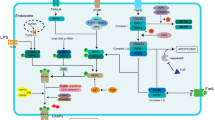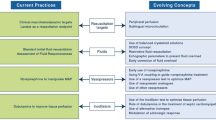Abstract
Purpose
A specific therapeutic strategy in sepsis-induced myocardial dysfunction remains to be determined. Nitrite may have cardioprotective effects against sepsis-induced myocardial dysfunction. This study investigated the cardioprotective effects of nitrite on myocardial function, mitochondrial bioenergetics, and its underlying molecular mechanisms in severe septic rats.
Methods
Sepsis was induced in male Wistar rats by cecal ligation and puncture (CLP). After CLP, we administered normal saline (NS group) or nitrite (nitrite group) subcutaneously. We administered nitrite at different doses (0.1–10 mg/kg) to ascertain the most effective dose and examined cardiac function in an isolated heart experiment 8 h after CLP. We investigated mitochondrial bioenergetics and molecular mechanisms underlying the administration of nitrite in vitro.
Results
In isolated heart experiments, the left ventricular developed pressure (96 ± 5 mmHg) at a moderate nitrite dose (1.0 mg/kg) was significantly higher than that in the NS group (75 ± 4 mmHg, P < 0.05). Mitochondrial oxidative phosphorylation in the nitrite group was significantly higher than that in the NS group (P < 0.01). Immunoblotting revealed that nitrite significantly increased the phosphorylation of Akt (P < 0.05) and reduced the nuclear translocation of NF-κB (P < 0.05) compared with the NS group. Nitrite was also shown to improve the rate of survival in severe septic rats (P < 0.001).
Conclusions
Our results showed that a moderate nitrite dose improved septic myocardial dysfunction at organ, cellular, and molecular levels via modulation of stress signal responses, which resulted in an improvement in survival.







Similar content being viewed by others
References
Angus DC, van der Poll T. Severe sepsis and septic shock. N Engl J Med. 2013;369:840–51.
López A, Lorente JA, Steingrub J, Bakker J, McLuckie A, Willatts S, Brockway M, Anzueto A, Holzapfel L, Breen D, Silverman MS, Takala J, Donaldson J, Arneson C, Grove G, Grossman S, Grover R. Multiple-center, randomized, placebo-controlled, double-blind study of the nitric oxide synthase inhibitor 546C88: effect on survival in patients with septic shock. Crit Care Med. 2004;32:21–30.
Dellinger RP, Levy MM, Rhodes A, Annane D, Gerlach H, Opal SM, Sevransky JE, Sprung CL, Douglas IS, Jaeschke R, Osborn TM, Nunnally ME, Townsend SR, Reinhart K, Kleinpell RM, Angus DC, Deutschman CS, Machado FR, Rubenfeld GD, Webb SA, Beale RJ, Vincent JL, Moreno R. Surviving sepsis campaign: international guidelines for management of severe sepsis and septic shock: 2012. Intensive Care Med. 2013;39:165–228.
Merx MW, Weber C. Sepsis and the heart. Circulation. 2007;116:793–802.
Landesberg G, Gilon D, Meroz Y, Georgieva M, Levin PD, Goodman S, Avidan A, Beeri R, Weissman C, Jaffe AS, Sprung CL. Diastolic dysfunction and mortality in severe sepsis and septic shock. Eur Heart J. 2012;33:895–903.
Rudiger A, Singer M. Mechanisms of sepsis-induced cardiac dysfunction. Crit Care Med. 2007;35:1599–608.
Dare AJ, Phillips AR, Hickey AJ, Mittal A, Loveday B, Thompson N, Windsor JA. A systematic review of experimental treatments for mitochondrial dysfunction in sepsis and multiple organ dysfunction syndrome. Free Radic Biol Med. 2009;47:1517–25.
Calvert JW, Lefer DJ. Clinical translation of nitrite therapy for cardiovascular diseases. Nitric Oxide. 2010;22:91–7.
Weitzberg E, Hezel M, Lundberg JO. Nitrate–nitrite–nitric oxide pathway: implications for anesthesiology and intensive care. Anesthesiology. 2010;113:1460–75.
Shiva S, Sack MN, Greer JJ, Duranski M, Ringwood LA, Burwell L, Wang X, MacArthur PH, Shoja A, Raghavachari N, Calvert JW, Brookes PS, Lefer DJ, Gladwin MT. Nitrite augments tolerance to ischemia/reperfusion injury via the modulation of mitochondrial electron transfer. J Exp Med. 2007;204:2089–102.
Gonzalez FM, Shiva S, Vincent PS, Ringwood LA, Hsu LY, Hon YY, Aletras AH, Cannon RO 3rd, Gladwin MT, Arai AE. Nitrite anion provides potent cytoprotective and antiapoptotic effects as adjunctive therapy to reperfusion for acute myocardial infarction. Circulation. 2008;117:2986–94.
Jung KH, Chu K, Ko SY, Lee ST, Sinn DI, Park DK, Kim JM, Song EC, Kim M, Roh JK. Early intravenous infusion of sodium nitrite protects brain against in vivo ischemia-reperfusion injury. Stroke. 2006;37:2744–50.
Matsuno K, Iwata K, Matsumoto M, Katsuyama M, Cui W, Murata A, Nakamura H, Ibi M, Ikami K, Zhang J, Matoba S, Jin D, Takai S, Matsubara H, Matsuda N, Yabe-Nishimura C. NOX1/NADPH oxidase is involved in endotoxin-induced cardiomyocyte apoptosis. Free Radic Biol Med. 2012;53:1718–28.
Jiang S, Zhu W, Li C, Zhang X, Lu T, Ding Z, Cao K, Liu L. α-Lipoic acid attenuates LPS-induced cardiac dysfunction through a PI3K/Akt-dependent mechanism. Int Immunopharmacol. 2013;16:100–7.
Landesberg G, Levin PD, Gilon D, Goodman S, Georgieva M, Weissman C, Jaffe AS, Sprung CL, Barak V. Myocardial dysfunction in severe sepsis and septic shock: no correlation with inflammatory cytokines in real-life clinical setting. Chest. 2015;148:93–102.
Yaghi A, Paterson NA, McCormack DG. Vascular reactivity in sepsis: importance of controls and role of nitric oxide. Am J Respir Crit Care Med. 1995;151:706–12.
Fujimura N, Sumita S, Aimono M, Masuda Y, Shichinohe Y, Narimatsu E, Namiki A. Effect of free radical scavengers on diaphragmatic contractility in septic peritonitis. Am J Respir Crit Care Med. 2000;162:2159–65.
Rittirsch D, Huber-Lang MS, Fileri MA, Ward PA. Immunodesign of experimental sepsis by cecal ligation and puncture. Nat Protoc. 2009;4:31–6.
Dyson A, Cone S, Singer M, Ackland GL. Microvascular and macrovascular flow are uncoupled in early polymicrobial sepsis. Br J Anaesth. 2012;108:973–8.
Hirata N, Shim YH, Pravdic D, Lohr NL, Pratt PF Jr, Weihrauch D, Kersten JR, Warltier DC, Bosnjak ZJ, Bienengraeber M. Isoflurane differentially modulates mitochondrial reactive oxygen species production via forward versus reverse electron transport flow: implications for preconditioning. Anesthesiology. 2011;115:531–40.
Moshage H, Kok B, Huizenga JR, Jansen PL. Nitrite and nitrate determinations in plasma: a critical evaluation. Clin Chem. 1995;41:892–6.
Cauwels A, Buys ES, Thoonen R, Geary L, Delanghe J, Shiva S, Brouckaert P. Nitrite protects against morbidity and mortality associated with TNF- or LPS-induced shock in a soluble guanylate cyclase-dependent manner. J Exp Med. 2009;206:2915–24.
Serita R, Morisaki H, Ai K, Morita Y, Innami Y, Satoh T, Kosugi S, Kotake Y, Takeda J. Sevoflurane preconditions stunned myocardium in septic but not healthy isolated rat hearts. Br J Anaesth. 2002;89:896–903.
Vieillard-Baron A, Caille V, Charron C, Belliard G, Page B, Jardin F. Actual incidence of global left ventricular hypokinesia in adult septic shock. Crit Care Med. 2008;36:1701–6.
Baker JE, Su J, Fu X, Hsu A, Gross GJ, Tweddell JS, Hogg N. Nitrite confers protection against myocardial infarction: role of xanthine oxidoreductase, NADPH oxidase and K(ATP) channels. J Mol Cell Cardiol. 2007;43:437–44.
Duranski MR, Greer JJ, Dejam A, Jaganmohan S, Hogg N, Langston W, Patel RP, Yet SF, Wang X, Kevil CG, Gladwin MT, Lefer DJ. Cytoprotective effects of nitrite during in vivo ischemia-reperfusion of the heart and liver. J Clin Invest. 2005;115:1232–40.
Pickerodt PA, Emery MJ, Zarndt R, Martin W, Francis RC, Boemke W, Swenson ER. Sodium nitrite mitigates ventilator-induced lung injury in rats. Anesthesiology. 2012;117:592–601.
Li H, Samouilov A, Liu X, Zweier JL. Characterization of the magnitude and kinetics of xanthine oxidase-catalyzed nitrate reduction: evaluation of its role in nitrite and nitric oxide generation in anoxic tissues. Biochemistry. 2003;42:1150–9.
Hinkle PC. P/O ratio of mitochondrial oxidative phosphorylation. Biochim Biophys Acta. 2005;1706:1–11.
Miyamoto S, Rubio M, Sussman MA. Nuclear and mitochondrial signalling Akts in cardiomyocytes. Cardiovasc Res. 2009;82:272–85.
Cherry AD, Piantadosi CA. Regulation of mitochondrial biogenesis and its intersection with inflammatory responses. Antioxid Redox Signal. 2015;22:965–76.
Szabó C, Módis K. Pathophysiological roles of peroxynitrite in circulatory shock. Shock. 2010;34(Suppl 1):4–14.
Meyer J, Traber DL. Nitric oxide and endotoxin shock. Cardiovasc Res. 1992;26:558.
Cauwels A, Vandendriessche B, Bultinck J, Descamps B, Rogge E, Van Nieuwenhuysen T, Sips M, Vanhove C, Brouckaert P. TLR2 activation causes no morbidity or cardiovascular failure, despite excessive systemic nitric oxide production. Cardiovasc Res. 2013;100:28–35.
Kimmoun A, Louis H, Al Kattani N, Delemazure J, Dessales N, Wei C, Marie PY, Issa K, Levy B. β1-Adrenergic inhibition improves cardiac and vascular function in experimental septic shock. Crit Care Med. 2015;43:e332–40.
Knowlton AA, Chen L, Malik ZA. Heart failure and mitochondrial dysfunction: the role of mitochondrial fission/fusion abnormalities and new therapeutic strategies. J Cardiovasc Pharmacol. 2014;63:196–206.
Wu LL, Ji Y, Dong LW, Liu MS. Calcium uptake by the sarcoplasmic reticulum is impaired during the hypodynamic phase of sepsis in the rat heart. Shock. 2011;15:49–55.
Celes MR, Malvestio LM, Suadicani SO, Prado CM, Figueiredo MJ, Campos EC, Freitas AC, Spray DC, Tanowitz HB, da Silva JS, Rossi MA. Disruption of calcium homeostasis in cardiomyocytes underlies cardiac structural and functional changes in severe sepsis. PLoS One. 2013;8:e68809.
WilliamS GS, Boyman L, Chikando AC, Khairallah RJ, Lederer WJ. Mitochondiral calcium uptake. Proc Natl Acad Sci USA. 2013;110:10479–86.
Funding
This work was supported in part by the Japan Society for the Promotion of Science (JSPS; Tokyo, Japan); Grant Nos. 25861724 and 15K20348.
Author information
Authors and Affiliations
Corresponding author
Ethics declarations
Conflict of interests
The authors declare no competing interests.
About this article
Cite this article
Kawaguchi, R., Hirata, N., Tokinaga, Y. et al. Nitrite administration improves sepsis-induced myocardial and mitochondrial dysfunction by modulating stress signal responses. J Anesth 31, 885–894 (2017). https://doi.org/10.1007/s00540-017-2417-0
Received:
Accepted:
Published:
Issue Date:
DOI: https://doi.org/10.1007/s00540-017-2417-0




